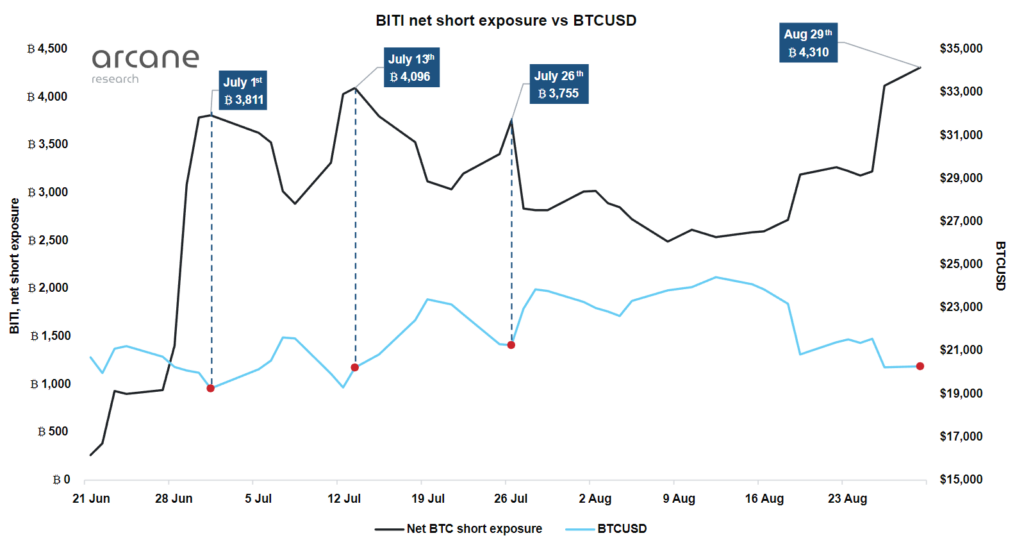Investors prepare for more market selloffs by shorting Bitcoin. Is this Ethereum's breakout moment?
After a brief mid-August rally, Bitcoin’s price has revisited June’s less exciting sideways maintenance within $20k. Meanwhile, inflows into short-Bitcoin investment products jumped to a record $18 million last week, rising to a total of $158 million AuM. Does this indicate a shift in digital asset bets as Ethereum’s Merge approaches?
Short-Bitcoin: A Bearish Momentum?
Even in bear markets, investors try to profit by making the right bets. If they speculate that an asset’s price will decline, they can short-sell it. In the case of Bitcoin, this can be done without directly trading on-chain, with the help of derivative funds that provide BTC price exposure.
From mid-August to September, Bitcoin shorting has increased by 70% on one of the largest short Bitcoin ETFs, ProShares Short Bitcoin Strategy ETF (NYSE:BITI).

Source: Arcane Research
The latest CoinShares report on digital asset fund allocation showed that Bitcoin outflows continued the 4th-week negative streak at $11.1 million. At the same time, short-Bitcoin investment funds increased inflows to a record $18 million over the last week, a new $158 million AuM record.
Despite the Ethereum’s Merge hype, it also saw a net negative flow, at $2.1 million outflows. In contrast, Ethereum’s competitors, Solana and Avalanche, had increased inflows, totaling at $0.5 million. The geographical distribution of investment flows is revealing. While Brazil, Germany, and Canada had $9.5 million in inflows combined, the US had only $0.8 million.
As noted previously, this results from Powell’s Jackson Hole speech. The Fed Chair clarified that the Federal Reserve would not stop interest rate hikes until the 2% target inflation rate is reached. Risk-on assets like cryptocurrencies usually fare poorly in a macroeconomic environment of monetary tightening.
Bitcoin Dominance and Ethereum’s Merge: Flippening Not Likely
We arrive at the real Bitcoin dominance index if we exclude centralized stablecoins and VC-funded ICO projects. It shows Bitcoin’s market cap share (dominance), at 63.29%. This level is getting closer to the two-year record low in May 2021, during the altcoin bull run.
If all cryptocurrencies are included, Ethereum’s dominance is at 20.3%, while Bitcoin’s dominance is at 39.5%. This 2x market cap difference tells us that Ethereum flippening, as market cap dominance reversal in favor of ETH, is highly unlikely.
At present Bitcoin’s price range of ~$20k, Ethereum would need to rise just above $3,120 per ETH for the flippening to happen, a 95% increase from the present ETH price of ~$1,593. An additional hurdle is that Ethereum doesn’t have a set maximum supply cap like Bitcoin. While the EIP-1559 burning mechanic counters Ethereum’s inflation rate, it would still have continuous inflationary pressure.
To counter it fully and spike demand, ETH utility would also have to increase drastically. In turn, ETH gas fees would have to go permanently under $0.5. While this would likely spark mass adoption, Ethereum’s main chain scaling is yet to happen in the Surge upgrade that introduces sharding, scheduled for late 2023.
Furthermore, despite having four times fewer daily transactions than Ethereum, Bitcoin has two times more active addresses.

With that said, Ethereum did flip Bitcoin in the Deribit options market for the first time ever in August, at $5.7b vs. $4.35b in favor of Ethereum. Excluding market upsets created by the Federal Reserve monetary, there is also the question of Ethereum’s decentralization once it becomes proof-of-stake.
OFAC’s sanction of Tornado Cash open-source protocol opened this Pandora’s box for the entire Ethereum ecosystem. Some of Ethereum’s own developers have stated that they will leave Ethereum if such censorship is allowed. Marius Van Der Wijden, Ethereum developer said,
”If we allow censorship of user transactions on the network, then we basically failed”.
Nonetheless, it remains uncertain if such transaction censorship concerns would impact Ethereum’s wider adoption. After all, investors typically follow the road of least resistance.
